This lecture deals with analytical methods in mathematics such as differential and integral calculus, focusing on the case of a single variable. It starts with the topic of “evaluation using inequalities,” which is not often used in the “mathematics of equations” in high school, and then discusses limit, convergence, infinite sums, differentiation, integration, approximate calculation, etc., in relation to the theory of Taylor expansion as the major subject. A more solid foundation will be given to mathematical analysis while knowledge learned in high school is fully utilized. It is important to gain a feel for theoretical problems through exercises and many examples, as well as to become familiar with various practical examples to be encountered in the future.

- 1. Introduction and evaluation using inequalities (1): Error and approximation
- 2. Evaluation using inequalities (2): Limit and ( ε , δ )-definition
- 3. Evaluation using inequalities (3): How to write a proof using the ( ε , δ )- definition of a limit and introduction to the Taylor expansion
- 4. What is the Taylor expansion: Examples and applications
- 5. Convergence/divergence of series sums, absolute convergence, conditional convergence
- 6. Simple method of determining convergence or divergence for series sums
- 7. Power series and its radius of convergence, Riemann’s zeta function, Taylor’s theorem
- 8. Topics from the mean-value theorem to Taylor’s theorem, evaluation of remainder terms using Taylor’s theorem
- 9. Use and application of the Taylor expansion: Calculation of approximate values and error evaluation, term-wise calculus, calculation of limits
- 10. New functions such as inverse trigonometric functions and Euler’s formula
- 11. Basics of integrals (1): Definition of definite integrals
- 12. Basics of integrals (2): Integrability of continuous functions
- 13. Improper integral and its convergence and divergence, examples of functions defined with improper integrals (gamma function, beta function)
- 14. Calculations of various integrals and corresponding problems leading to them
-
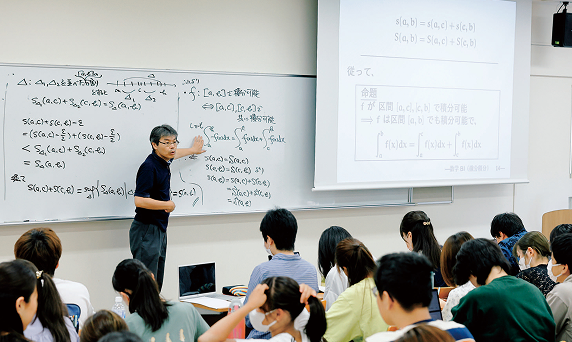 Lectures are most important in the mathematics course, and it is essential to take thorough notes on what is written on the blackboard. Computers are also used for drawing graphs, etc., to make the lectures easy to understand.
Lectures are most important in the mathematics course, and it is essential to take thorough notes on what is written on the blackboard. Computers are also used for drawing graphs, etc., to make the lectures easy to understand. -
 Students are intently listening to the explanation. Their full concentration is required.
Students are intently listening to the explanation. Their full concentration is required. -
 Students may sometimes overreact owing to excitement during a lecture.
Students may sometimes overreact owing to excitement during a lecture. -
 Friendly atmosphere. Let’s have fun learning.
Friendly atmosphere. Let’s have fun learning. -
 Some students have taken notes on tablets lately.
Some students have taken notes on tablets lately. -
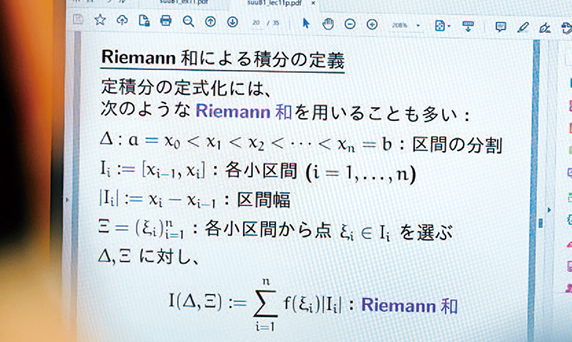 Sometimes students refer to lecture materials using a PC or a smartphone.
Sometimes students refer to lecture materials using a PC or a smartphone.
Chemistry is the scientific study of properties and chemical changes of matter. This lecture will provide an understanding of (1) the basics of chemistry and atomic structure, (2) the periodicity of elements, (3) chemical bonds, and (4) the shapes of molecules, necessary for science and engineering students to understand basic chemistry. Specifically, an explanation is given of the structure of atoms, the configuration and energy states of electrons, various forms of chemical bonds such as ionic bonds, metallic bonds, hydrogen bonds, etc., and the concept of chemical bonds and the structure of molecules based on molecular orbitals. Under Curriculum Policy 1 and as the subject of FST General Subject Group 1, the lecture aims to provide an understanding of the basics of natural science and to cultivate a sense of safety and ethics in science and technology.

- 1. What is basic chemistry? Essential items
- 2. Atomic structure and properties I: Hydrogen atom
- 3. Atomic structure and properties II: Multi-electron atoms
- 4. Atomic structure and properties III: Electron configuration
- 5. Atomic structure and properties IV: Atomic radius and ionic radius
- 6. Atomic structure and properties V: Periodicity in properties of elements
- 7. Midterm examination
- 8. Midterm examination: Explanation and review
- 9. Chemical bonds I: Ionic bonds
- 10. Chemical bonds II: Covalent bonds
- 11. Chemical bonds III: Molecular orbital theory
- 12. Chemical bonds IV: Metallic bonds
- 13. Chemical bonds V: Hybrid orbital
- 14. Chemical bonds VI: Intermolecular interactions
-
 Students are concentrating, taking in every word.
Students are concentrating, taking in every word. -
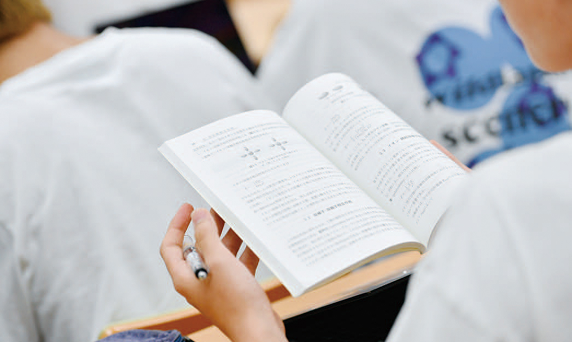 Going through handouts and textbooks.
Going through handouts and textbooks. -
 It is important to listen carefully and write down notes.
It is important to listen carefully and write down notes. -
 Proceed with the lecture while showing video materials.
Proceed with the lecture while showing video materials. -
 The textbook used in the lecture.
The textbook used in the lecture.
(elective course for the first and second years)
Students learn the basics of programming. In computer operation, it is necessary to write the processing contents into a program. The C language is used for this purpose. Students learn three major elements constituting the programming control structure: sequential, iterative, and branching. The goal is to understand the program elements, such as variables, types, conditional branches, repetitions, arrays, and functions; the program structures; and the processing flow, by developing and executing actual programs.

- 1. Compile and execute. Display characters
- 2. Number input and variables
- 3. Conditional branch
- 4. Repetition
- 5. Auxiliary variables
- 6. Subroutine
- 7. Arrays
- 8. Recursion
- 9. Global variables, local variables, and static variables
- 10. Strings
- 11. File input and output
- 12. Pointers
- 13. Various programs
- 14. Integrated study
-
 In programming exercises, students themselves write, execute, and debug programs repeatedly.
In programming exercises, students themselves write, execute, and debug programs repeatedly. -
 Students are examining the execution results and programs.
Students are examining the execution results and programs. -
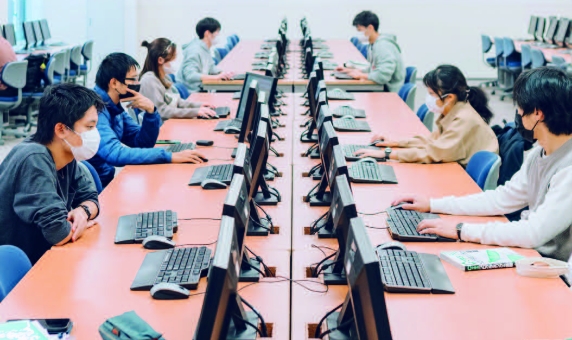 Those logging in remotely can see students in the classroom sitting in every other row.
Those logging in remotely can see students in the classroom sitting in every other row. -
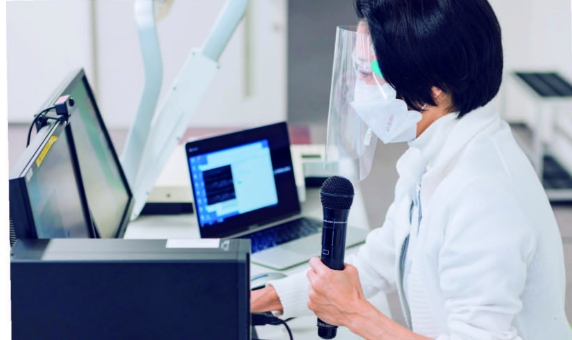 Classes are of a Hybrid-Flexible (HyFlex) style, and lectures are given for both students in the classroom and students attending online via Zoom.
Classes are of a Hybrid-Flexible (HyFlex) style, and lectures are given for both students in the classroom and students attending online via Zoom. -
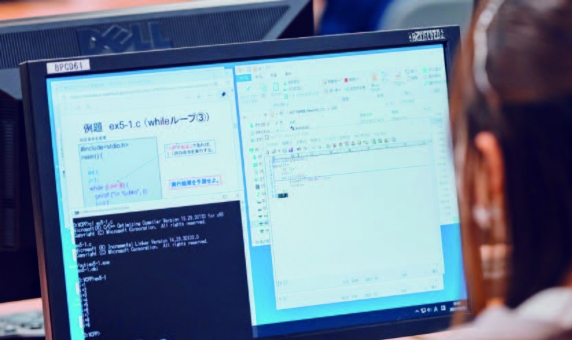 Materials uploaded to Moodle, editor for writing programs, and a shell window for executing compilation (black window).
Materials uploaded to Moodle, editor for writing programs, and a shell window for executing compilation (black window). -
 Teaching material used in this class.
Teaching material used in this class.
(elective course for the second and third years)
Quantum mechanics can describe the state near absolute zero temperature. Statistical mechanics is necessary to understand the state of many particle systems at nonzero temperature. At absolute zero temperature, the internal energy is a minimum. At nonzero temperature, the state is determined by the competition between the internal energy and the tendency to increase entropy (disorder). In this lecture, students learn statistical mechanics through discussions of these principles from a microscopic point of view. Specifically, topics include the microscopic description of entropy, a two-level system as a model of a permanent magnet (ferromagnetic material), derivation of the equation of state for an ideal gas, description of ferromagnetic phase transition using molecular field approximation, etc., as an introduction to quantum statistical mechanics.

- 1. Why is statistical physics important?
Difference between thermodynamics and quantum mechanics - 2. Entropy and principle of equal a priori weights – Boltzmann’s formula
- 3. Microcanonical method – Stirling’s approximation
- 4. Determination of various thermodynamic quantities
- 5. The second law of thermodynamics and Helmholtz free energy
- 6. Phase transitions and Landau’s phenomenology
- 7. Spin-spin interaction and molecular field approximation
- 8. Limitations of microcanonical method and introduction of canonical method
- 9. Mastering the partition function
- 10. Ideal gas – Equation of state and equipartition law
- 11. Ideal gas – Entropy becomes negative and diverges at low temperatures?
- 12. Harmonic oscillators – Do all solids have the same specific heat?
- 13. Need for quantum statistics (fermions and bosons). Are free electrons really free?
- 14. Difference between Bose statistics and classical statistics. Why no green stars?
-
 Students deepen understanding by combining distributed lecture notes, writing on the blackboard, and listening to the lecturer in a complementary manner.
Students deepen understanding by combining distributed lecture notes, writing on the blackboard, and listening to the lecturer in a complementary manner. -
 During the lecture, students solve a mini quiz on Zoom and check their understanding while having fun.
During the lecture, students solve a mini quiz on Zoom and check their understanding while having fun. -
 After each class, students are required to submit a reaction paper as an indication of commitment to the class.
After each class, students are required to submit a reaction paper as an indication of commitment to the class. -
 In this lecture, it is discussed that the Helmholtz free energy becomes minimum in the thermal equilibrium state.
In this lecture, it is discussed that the Helmholtz free energy becomes minimum in the thermal equilibrium state. -
 Writing by hand is the first step to understanding.
Writing by hand is the first step to understanding.










 Materials and Life Science
Materials and Life Science
 Engineering and Applied Sciences
Engineering and Applied Sciences
 Information and Communication Sciences
Information and Communication Sciences






